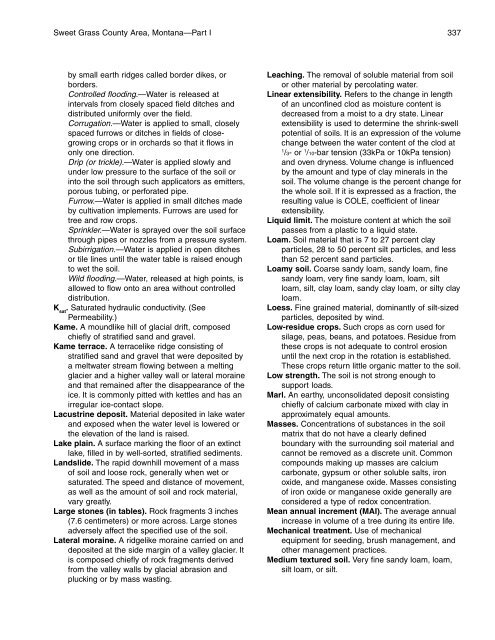Soil Survey of Sweet Grass County Area, Montana - Soil Data Mart
Soil Survey of Sweet Grass County Area, Montana - Soil Data Mart
Soil Survey of Sweet Grass County Area, Montana - Soil Data Mart
You also want an ePaper? Increase the reach of your titles
YUMPU automatically turns print PDFs into web optimized ePapers that Google loves.
<strong>Sweet</strong> <strong>Grass</strong> <strong>County</strong> <strong>Area</strong>, <strong>Montana</strong>—Part I 337<br />
by small earth ridges called border dikes, or<br />
borders.<br />
Controlled flooding.—Water is released at<br />
intervals from closely spaced field ditches and<br />
distributed uniformly over the field.<br />
Corrugation.—Water is applied to small, closely<br />
spaced furrows or ditches in fields <strong>of</strong> closegrowing<br />
crops or in orchards so that it flows in<br />
only one direction.<br />
Drip (or trickle).—Water is applied slowly and<br />
under low pressure to the surface <strong>of</strong> the soil or<br />
into the soil through such applicators as emitters,<br />
porous tubing, or perforated pipe.<br />
Furrow.—Water is applied in small ditches made<br />
by cultivation implements. Furrows are used for<br />
tree and row crops.<br />
Sprinkler.—Water is sprayed over the soil surface<br />
through pipes or nozzles from a pressure system.<br />
Subirrigation.—Water is applied in open ditches<br />
or tile lines until the water table is raised enough<br />
to wet the soil.<br />
Wild flooding.—Water, released at high points, is<br />
allowed to flow onto an area without controlled<br />
distribution.<br />
K sat<br />
. Saturated hydraulic conductivity. (See<br />
Permeability.)<br />
Kame. A moundlike hill <strong>of</strong> glacial drift, composed<br />
chiefly <strong>of</strong> stratified sand and gravel.<br />
Kame terrace. A terracelike ridge consisting <strong>of</strong><br />
stratified sand and gravel that were deposited by<br />
a meltwater stream flowing between a melting<br />
glacier and a higher valley wall or lateral moraine<br />
and that remained after the disappearance <strong>of</strong> the<br />
ice. It is commonly pitted with kettles and has an<br />
irregular ice-contact slope.<br />
Lacustrine deposit. Material deposited in lake water<br />
and exposed when the water level is lowered or<br />
the elevation <strong>of</strong> the land is raised.<br />
Lake plain. A surface marking the floor <strong>of</strong> an extinct<br />
lake, filled in by well-sorted, stratified sediments.<br />
Landslide. The rapid downhill movement <strong>of</strong> a mass<br />
<strong>of</strong> soil and loose rock, generally when wet or<br />
saturated. The speed and distance <strong>of</strong> movement,<br />
as well as the amount <strong>of</strong> soil and rock material,<br />
vary greatly.<br />
Large stones (in tables). Rock fragments 3 inches<br />
(7.6 centimeters) or more across. Large stones<br />
adversely affect the specified use <strong>of</strong> the soil.<br />
Lateral moraine. A ridgelike moraine carried on and<br />
deposited at the side margin <strong>of</strong> a valley glacier. It<br />
is composed chiefly <strong>of</strong> rock fragments derived<br />
from the valley walls by glacial abrasion and<br />
plucking or by mass wasting.<br />
Leaching. The removal <strong>of</strong> soluble material from soil<br />
or other material by percolating water.<br />
Linear extensibility. Refers to the change in length<br />
<strong>of</strong> an unconfined clod as moisture content is<br />
decreased from a moist to a dry state. Linear<br />
extensibility is used to determine the shrink-swell<br />
potential <strong>of</strong> soils. It is an expression <strong>of</strong> the volume<br />
change between the water content <strong>of</strong> the clod at<br />
1<br />
/3- or 1 /10-bar tension (33kPa or 10kPa tension)<br />
and oven dryness. Volume change is influenced<br />
by the amount and type <strong>of</strong> clay minerals in the<br />
soil. The volume change is the percent change for<br />
the whole soil. If it is expressed as a fraction, the<br />
resulting value is COLE, coefficient <strong>of</strong> linear<br />
extensibility.<br />
Liquid limit. The moisture content at which the soil<br />
passes from a plastic to a liquid state.<br />
Loam. <strong>Soil</strong> material that is 7 to 27 percent clay<br />
particles, 28 to 50 percent silt particles, and less<br />
than 52 percent sand particles.<br />
Loamy soil. Coarse sandy loam, sandy loam, fine<br />
sandy loam, very fine sandy loam, loam, silt<br />
loam, silt, clay loam, sandy clay loam, or silty clay<br />
loam.<br />
Loess. Fine grained material, dominantly <strong>of</strong> silt-sized<br />
particles, deposited by wind.<br />
Low-residue crops. Such crops as corn used for<br />
silage, peas, beans, and potatoes. Residue from<br />
these crops is not adequate to control erosion<br />
until the next crop in the rotation is established.<br />
These crops return little organic matter to the soil.<br />
Low strength. The soil is not strong enough to<br />
support loads.<br />
Marl. An earthy, unconsolidated deposit consisting<br />
chiefly <strong>of</strong> calcium carbonate mixed with clay in<br />
approximately equal amounts.<br />
Masses. Concentrations <strong>of</strong> substances in the soil<br />
matrix that do not have a clearly defined<br />
boundary with the surrounding soil material and<br />
cannot be removed as a discrete unit. Common<br />
compounds making up masses are calcium<br />
carbonate, gypsum or other soluble salts, iron<br />
oxide, and manganese oxide. Masses consisting<br />
<strong>of</strong> iron oxide or manganese oxide generally are<br />
considered a type <strong>of</strong> redox concentration.<br />
Mean annual increment (MAI). The average annual<br />
increase in volume <strong>of</strong> a tree during its entire life.<br />
Mechanical treatment. Use <strong>of</strong> mechanical<br />
equipment for seeding, brush management, and<br />
other management practices.<br />
Medium textured soil. Very fine sandy loam, loam,<br />
silt loam, or silt.
















